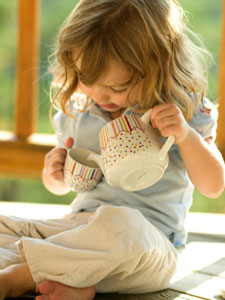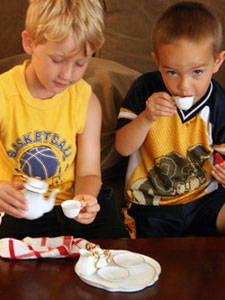Showing Children the Way to Tea


Before my daughter, Penelope, was even born, she had a tea party set. Two, actually, courtesy of my brother and best friend. They assumed that as a tea lover I would want to share my passion with my daughter, and they were right. I think tea parties lay a great tea foundation on which kids can build the knowledge of how to properly prepare, appreciate, and share tea. Not only are they a creative outlet for a child's imagination, but they introduce some of the basics of good tea preparation (not to mention some manners and etiquette). Somewhere between a child's first tea party and their first cup of real tea, however, tea loses its magical appeal and becomes an ordinary adults-only beverage. Why does this happen? The difference between a tea party and actual tea habits is behavior.
Tea parties are a fun and natural way to pave a little one's way to real tea, and they definitely introduce tea in the esteemed way it should be. For starters, they promote preparation of tea in teapots, as opposed to in mugs with tea bags. They encourage ingenuous and exuberant enjoyment and appreciation at any time, in any state of health. They endorse consumption in happy groups of people who may even dress up for the occasion because drinking tea is something special. Unfortunately, in the US at least, tea parties tend to promote a romanticized and idealistic concept of tea that contradicts the reality of tea: many people have tea parties one way but drink tea another. Thus, children learn that pretending to drink tea is very different from actually drinking tea. If the imagination of tea parties gets closer to reality, children will learn how to properly take tea. Monkey see, monkey do, as they say, and if your little one sees you break out tea bags while they're pouring invisible tea from teapots—a piece that is the central object of any tea set but absent from many kitchens—they will eventually learn that teapots are just for playing and that real tea comes from a mug with a tea bag floating in it. (I should note here that one of Penelope's tea sets does have a fake teabag painted inside the teapot, with the string and paper tab painted on the outside. Sigh.)
The disparity between tea play versus tea consumption has really got me thinking. Above all, it has me considering how I can maintain the lessons learned about tea from tea parties when transitioning Penelope from the invisible fake stuff to the reddish-brown real stuff. She is not even 2 years old yet, but she already has some of the basics down just from observing me and playing tea party. She knows tea is HOT, made in a pot, drank, and can be shared and doctored with milk and sugar. This makes for a great start, I think. To keep up with her learning, I will also teach her that real tea is:
Speaking of caffeine, I think this is the most obvious thing to consider when deciding when to first share a real cup of tea with your child. True teas (black, white, oolong, and green) contain caffeine, and really, what child needs anything that will result in additional hyperactivity, right? Call me crazy, but I'm not all that worried about the caffeine content. When I do finally let Penelope start drinking tea, she will not be drinking it daily or in copious quantities, so I do not expect her to be bouncing off the walls or not going to bed at night. Although I am not concerned, however, I will probably begin by introducing her to a caffeine-free herbal infusion or rooibos and save the caffeine for when she's older.
I don't know yet when I will introduce real tea to my daughter, but I look forward to doing so in a way that her palate, as well as her definition of tea, will be broad. I know that all of my efforts now will culminate in her enjoying tea later. She is still a few years away from my sharing a pot of real tea with her, but I have begun fantasizing about how I will, as I like to say, "bring her to tea." Until she is at an age when she can enjoy a hot beverage of her own, I'll just share little tastes of my own tea with her. I think her first solo cup of tea will be Rooibos Cinnamon Apple, not because it is caffeine-free, but because I think the flavor is particularly child friendly. I will most certainly involve her in the prep by letting her scoop the tea leaves into the pot and set the timer while it brews. I believe that including her in the preparation will increase her enjoyment of the finished product (some studies have even shown that children are more likely to consume foods that they have helped prepare). It will be one more thing we have in common and can enjoy together. At least until she becomes a teenager and shuns me and my tea for decadent and ridiculous coffee-based beverages, that is.
The bottom line is that tea does not have to loose its luster for children. Keep the tea party alive and help your child love tea for life, and for real!
How did you bring your child to tea?
